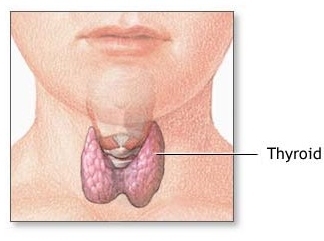An Unexpected Consequence of the Fukushima Disaster

The thyroid gland is an important part of the endocrine system.
On March 11 of 2011, the most powerful earthquake known to have hit Japan struck near the east coast of Honshu. The earthquake generated a tsunami that reached a height of more than 130 feet. One of the many things that happened as a consequence of the disaster is that some of the reactors at the Fukushima Daiichi Nuclear Power Plant went into meltdown, and radioactive substances were leaked into the ocean and released into the air. People in a 12-mile radius around the power plant were evacuated. I have written several posts about the incident (here, here, here, here, and here), and I will continue to do so whenever new information comes to light.Much of the discussion about the nuclear power plant disaster revolves around its long-term consequences. Since we know increased exposure to radiation can lead to an increase in cancer risk, it is natural to think that there will be an increase in cancer rates for people who were living or are living near the disaster site. Thyroid cancer is particularly sensitive to a common radioactive product of nuclear power plants, so it is assumed that thyroid cancer rates will climb in Fukushima. Indeed, a recent study shows a significant, persistent increase in thyroid cancers in the Ukraine that can be directly tied to the Chernobyl nuclear power plant disaster of 1986.1
Two of my previous posts (here and here) discussed the projected increase in cancer rates as a result of the Fukushima Daiichi disaster, and the balance of the evidence seemed to indicate that the increase would be rather small. However, in order to get a more direct measurement of thyroid cancers resulting from the disaster, Japanese authorities decided to screen all 368,651 Fukushima residents who were under 18 at the time of the disaster. An advanced technique (ultrasound) was used, and the results were surprising!
According to the initial analysis, the residents under 18 were up to 30 times (3,000%) more likely to have the signs of thyroid cancer than the rest of the Japanese population.2 This was unexpected for two reasons: First, the screenings took place soon after the disaster. It was thought that it would take years for significant signs of thyroid cancer to develop. Second, the Fukushima Daiichi disaster released a lot less radiation into the environment than the Chernobyl disaster, but it seemed to result in more than four times as much thyroid cancer.
Because of these surprising results, some researchers questioned the methodology used in the analysis. Specifically, they noted that the ultrasound screening employed in Fukushima is a very sensitive technique that hasn’t been widely used in Japan. They wondered if the increase in signs of thyroid cancer were simply the result of using this better screening method. As a result, some researchers decided to use the exact same method on residents of three other parts of Japan (Aomori, Yamanashi and Nagasaki) that were not exposed to significant amounts of radiation from the Fukushima Daiichi disaster. They found signs of cancer at an even higher rate than what was found in the Fukushima study!3
Because of statistical effects, the authors couldn’t say whether their results were really higher than that of the Fukushima study. As a result, they concluded that their results were very similar to those of the Fukushima report. This led them to write:
Our results suggest that ultrasound thyroid findings in children may change with a relatively short-term passing period, and that thyroid cancer may exist at a very low but certain frequency in the general childhood population.
Now please understand that the group doing the Fukushima study doesn’t agree. Indeed, they wrote a follow-up paper trying to make the case that the large number of thyroid cases they found was, indeed, related to the nuclear disaster.4 Unfortunately, their main argument revolves around the fact that in a later screening, they found signs of cancer in patients who were previously determined to be cancer-free. However, that’s exactly what you would expect if the conclusion quoted above is correct!
In the end, I think the balance of the evidence seems to indicate that an increase in thyroid cancer rates has not been seen as a result of the Fukushima Daiichi disaster. However, the studies are continuing, so we should get a better handle on this issue in several years. For right now, however, I think these results provide an important insight into the way medical research needs to be done. Just because you expect something to happen, and just because the initial studies support your expectation, that doesn’t mean your expectation is correct. Critical analysis must be done to make sure the initial studies aren’t fooling you!
REFERENCES
Jay L. Wile's Blog
- Jay L. Wile's profile
- 31 followers



